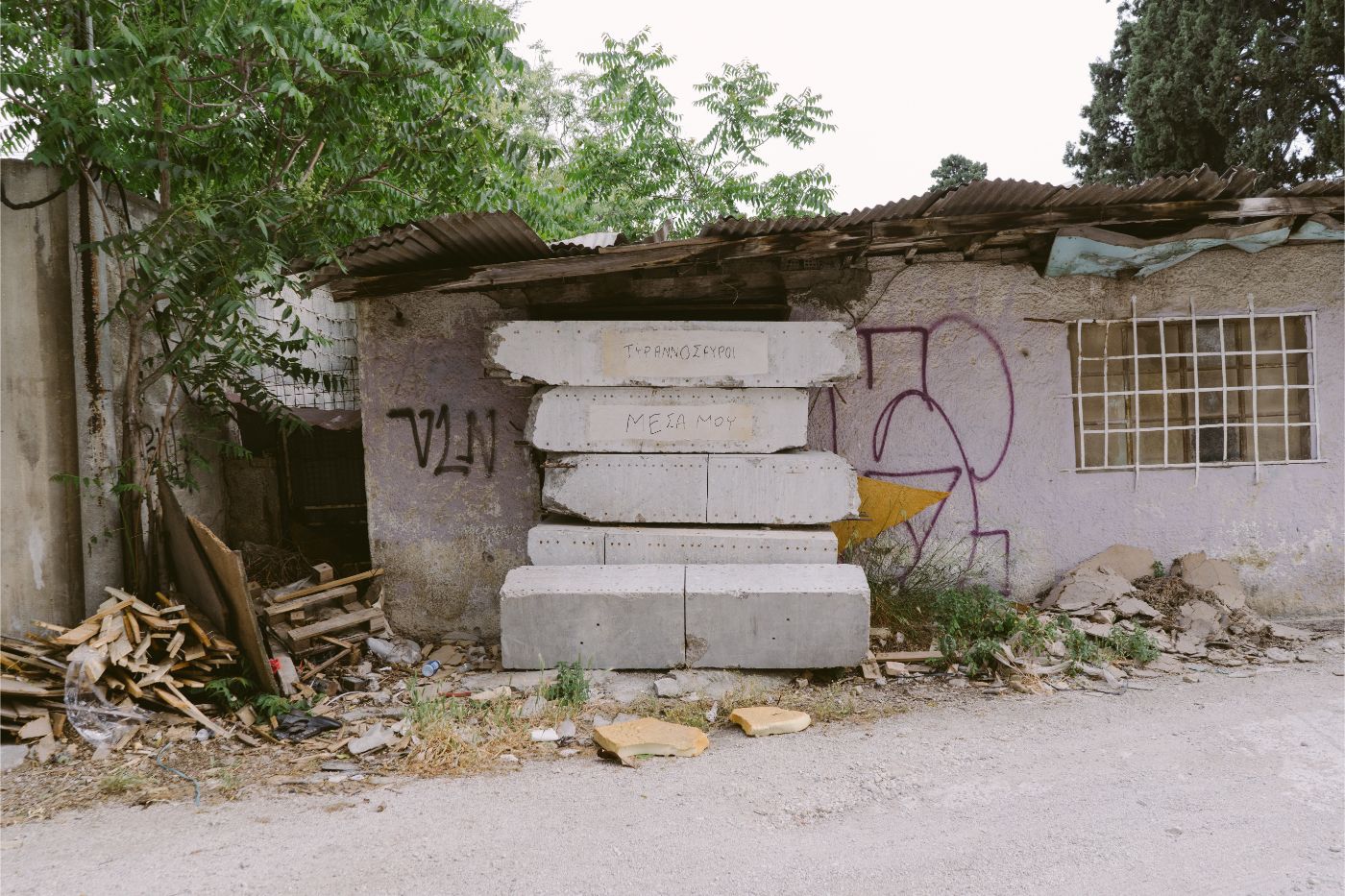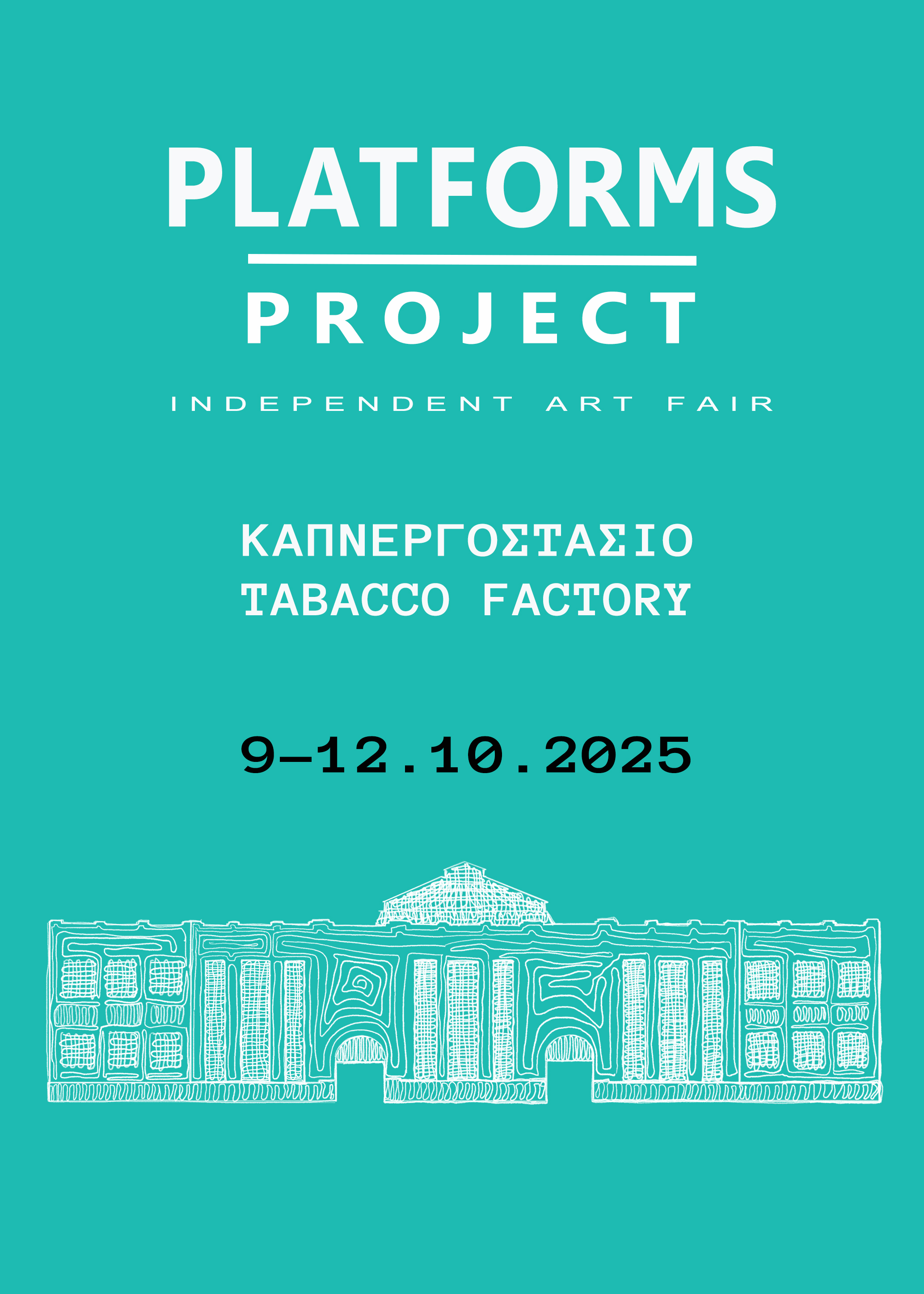Entrypoint
White Island Good View is a project by visual artist Vasilis Botoulas and writer Kiriakos Spirou. It was organised by und. and curated by Kiriakos Spirou between March and May 2019. It is in fact an exhibition that takes place in public space, for reasons that may or may not become apparent in the following paragraphs. I use the present tense because technically we never uninstalled the exhibition: we left the works out on the street and we don’t know what has happened to them since. (You can still go there and find traces of what we did. Send us a photo if you do.)
Our site was Lefkados Street in Moschato, Athens. At first we thought the street was in Kallithea, hence the name of the project (Λευκάδα = White Island, Καλλιθέα = Good View). The idea was to activate the area between the Athens School of Fine Arts and the Kallithea train station, because a lot of people were going to be walking there during Platforms Project.
The project is site-specific. We did many visits to the site and collected information and materials from there. We also decided that we would use only materials collected from the street to create the works. That rule we broke in the final days of the project by bringing more paper, photographs and painting materials to the site.
The artworks were installed on the street at various locations. Some were permanent interventions, others were temporary objects affixed on metal surfaces with magnets. We pasted texts, made graffiti, planted two cacti, opened a hole on a wall and painted it white. All these we did at various stages of the project, but most were made during the final days in order to avoid other people altering them.
We were impressed by the life we discovered on the street. Some buildings house large commercial enterprises, like a furniture company, the headquarters of a large toy-store chain, a signage manufacturer, an importer of detergents. There were also smaller businesses, like a shoe manufacturer, a truck garage, a café, a couple of carpenters, a print house, warehouses. On the street there is also a house where a group of people live that make their living by collecting recyclable paper from the streets; and a homeless man from Morocco living inside an abandoned warehouse that seems to have been destroyed by fire some time ago.
The photos in this article are presented in the actual order of the works on the street, starting from Lefkados 28 and going west.





Shyness
It is a wonderful thing when you’re looking, but not for something in particular. Sometimes I think there’s something to learn from artists who lie, as long as they make us look for things instead of showing us things. White Island Good View is a project that has become visible in many different ways, including an exhibition. An enormous effort has been made to make this materialise, yet the works are almost invisible. They blend into their surroundings. They camouflage themselves by constantly recessing into the unassuming, in a deliberate attempt to not stand out. We liked that. Visiting the exhibition puts you in a condition of looking for something that is there, but you don’t know what it is. As a result, you see much more than there is. Deception strategies? Perhaps. In any case, it was intentional.


Inhale
When I decided to do an exhibition in public space, my first question was how to establish a relationship with distance. A street’s main function is to help us cover distances faster, so I wanted to experiment with the idea of installing an exhibition that covers all 700 meters of Lefkados Street without increasing its density. In other words, somehow think of an exhibition that could fit into a typical white-box gallery, but explode its contents across the whole length of the street. As a result, the works had a distance of between 10-100 meters from one another. (If you didn’t see some of them, the distance grew.) In a gallery, the transition from one work to the other takes a few steps, and only as long as your eyes need to travel from one part of the wall to another. In White Island Good View, this transition is a literal walk. Most works have been installed in such a way that you can’t see the rest. It is therefore an expedition into losing sight, of singular encounters that persist. Of ingesting what has been seen, of seeing being a matter of remembering. Moving from one work to the next is like holding your breath. I discovered that holding your breath is not the same as not breathing.



Palindrome
It was essential to keep the exhibition open in terms of how it can be read and accessed. Lefkados Street has many entry points, and the fact that it cuts across all streets leading from the Kallithea train station to Athens School of Fine Arts means that the exhibition flow would always intersect the flow of people moving between the two points. Visitors come and go, back and forth, just as trains come and go at the nearby station. In our invitation we encouraged visitors to experience White Island Good View as a palindrome, which means to see the whole exhibition, then walk all the way back to where they started. This double take, a reverse repetition, creates new readings and triggers new connections. It also encourages visitors to turn the exhibition on its head, or simply wander off on their way back to make their own observations.















Stationery
There’s a lot of writing on the walls of Lefkados Street. Being so close to the ASFA means that art students would often use the area for graffiti, murals and experiments. But the whole idea of architectural materials as stationery came to me while walking down Lefkados one day, trying to find my way into the project as a writer. I felt compelled to use any material I could find as a writing surface, to fill objects with words. Gradually, I came to see White Island Good View as a depository of writing, some of which is non-verbal, as Vasilis often works with writing tools to create purely visual work. Brushstrokes, colour blocks, paint-covered salvaged wood, pasted texts — all these relate to affixing writing to a surface. In turn, this treatment of the site led to a reading of it as scripture, drawing attention to all writing found on the street and activating what had already been written there. Two of Vasilis’s graffiti were in fact white patches covering existing tags — again, adding to the idea of reading/writing, only in this case that which was written is now rendered unreadable.




Epistolary
Every work that is part of White Island Good View is a temporary object in transit. It can be removed, altered or copied freely, by anyone, for any purpose. The objects and writings we have deposited on Lefkados Street are like letters left on the street to reach an unknown recipient. (Do you read me? Will you read me?) It was also interesting to experiment with the idea of the ruin as a letter from the past that is being read in the present. A ruin (and there are many ruins on Lefkados Street) is a contemporary site bearing past information. Suddenly, a wormhole opens and we try to make what we can of its fleeting images. Our relationship to the space becomes linear, running along this line of exchange between sender and recipient, past and present, like a dog leashed on a clothesline. We see things that have remained and we decipher them. We pick up notebooks and letters from strangers that were discarded, not meant to be read. Pages, scripture, private fragments: they come and go, bearing messages.



Autochthony
A site-specific project can create a connection with its location in many ways. We decided to set the rule that the materials used would be that connection. The works created for the exhibition used materials found only on Lefkados Street, and as such they defined the final result. We collected a lot of scrap paper from the local recyclers, pieces of scrap plastic, fabrics, wooden pieces, leaves, rocks and many other objects that we took away to our studios to process and work with. Vasilis decided to paint some of these objects over. I mostly used them for collages and as writing surfaces. Stavros Rossos, our graphic designer, also followed the same rule, and used objects from the street to create the visuals for the White Island Good View pamphlet. As such, all the works seem to grow out of their environment. The fact that they sometimes seem transparent or camouflaged is a matter of seeing and not of their making: just as colonialists see indigenous people as part of the landscape, so do we see the objects that belong in their context as homogenous, flat.






Resistance
The more time I spent on Lefkados Street, the more I realised that the private spills into the public by default. It is perhaps the flow of human collateral, or the fact that we need to live a big part of our lives outside, that the most secret, tender, vulnerable parts of us are constantly being drawn into the light of the commons. In fact, the tender quietness of privacy is whatever we manage to salvage from the constant demands of public life. Our private lives are the result of personal resistance. In that sense, I worked on Lefkados Street with the understanding that a façade is a solidified crust, a shell that the private develops in the process of resisting the public. If you walk barefoot a lot, your soles will eventually become hardened. A soft, quiet life needs a hardened shell to exist. Every façade is a shell that has grown to resist the corrosive flows of public life. Inevitably, the shell bears traces and signals of what’s inside. Those signals I tried to read and translate into other things.



Exhale

















